It takes about ten words to go from your recipient’s inbox to their spam folder.
We don’t mean the first ten words in your opening paragraph. You’ll be lucky if your readers get that far.
We mean your email subject lines. Yes, those 40-70 characters can make or break your email marketing campaign.
If you’re not paying attention to subject lines, it won’t matter how good your email content is, you’ve got a one-way ticket to the spam folder or the trash bin — neither of which are great places to be.
Still don’t believe us? Check out these statistics:
- 47% of email recipients open emails based on the subject line
- 69% of email recipients report email as spam based on the subject line
- 1 in 6 emails end up on the spam folder or blocked altogether
What exactly constitutes a good email subject line? How can you write a click-worthy subject line, time and time again? Scroll on.
Don’t wait for the muse. Apply this step-by-step method to write high-performing email campaigns in hours, not weeks.
What can a good email subject line do for your SaaS?
Email marketing is hugely important in the SaaS industry. In fact, research shows that for every dollar a brand invests in email marketing, they receive $42 in return.
It allows brands to communicate and learn from their users, as well as the opportunity to track behaviors and see how subscribers respond to different content — which can inform further in-app and email comms.
Your subject line is a segue into this email magic.
A good email subject line in your SaaS email marketing can help you:
- Drive up open rates
- Increase brand awareness
- Help you avoid the spam folder
- Build positive brand sentiment
- Keep your recipients engaged
- Push users back into your app
A catchy SaaS email subject line is personal, short, and makes the recipient want to open that email.
Forget about indirect or underwhelming subject lines — they’re a thing of the past. Get ready to write click-worthy, instant-open, and smile-producing subject lines.
50+ real-life examples of great email subject lines 👀📩
We’ve scoured our inboxes and collected over 50 real-life examples of great email subject lines. Let’s explore what made them great — the psychology behind their success — and how you can use them as a template for achieving higher open rates.
Funny SaaS email subject lines
According to Jennifer Aaker, a professor at Stanford:
“Humor does more than just make people laugh. It allows you to connect with your audience, diffuse tension, elevate status, foster trust, and compel others to your point of view.”
Being funny in your subject lines will require more creativity, but its results will be worth it.
77% of users report boredom as the main reason for checking emails, it’s up to you to serve as a healthy distraction. All you need to do is entice them with humor.
At Userlist, we use the formula from the popular 90’s sitcom, Friends. We use their episode naming format (“The One with the…”) for our subject lines and it’s pretty effective. Here’s a screenshot of our lead nurturing campaign:
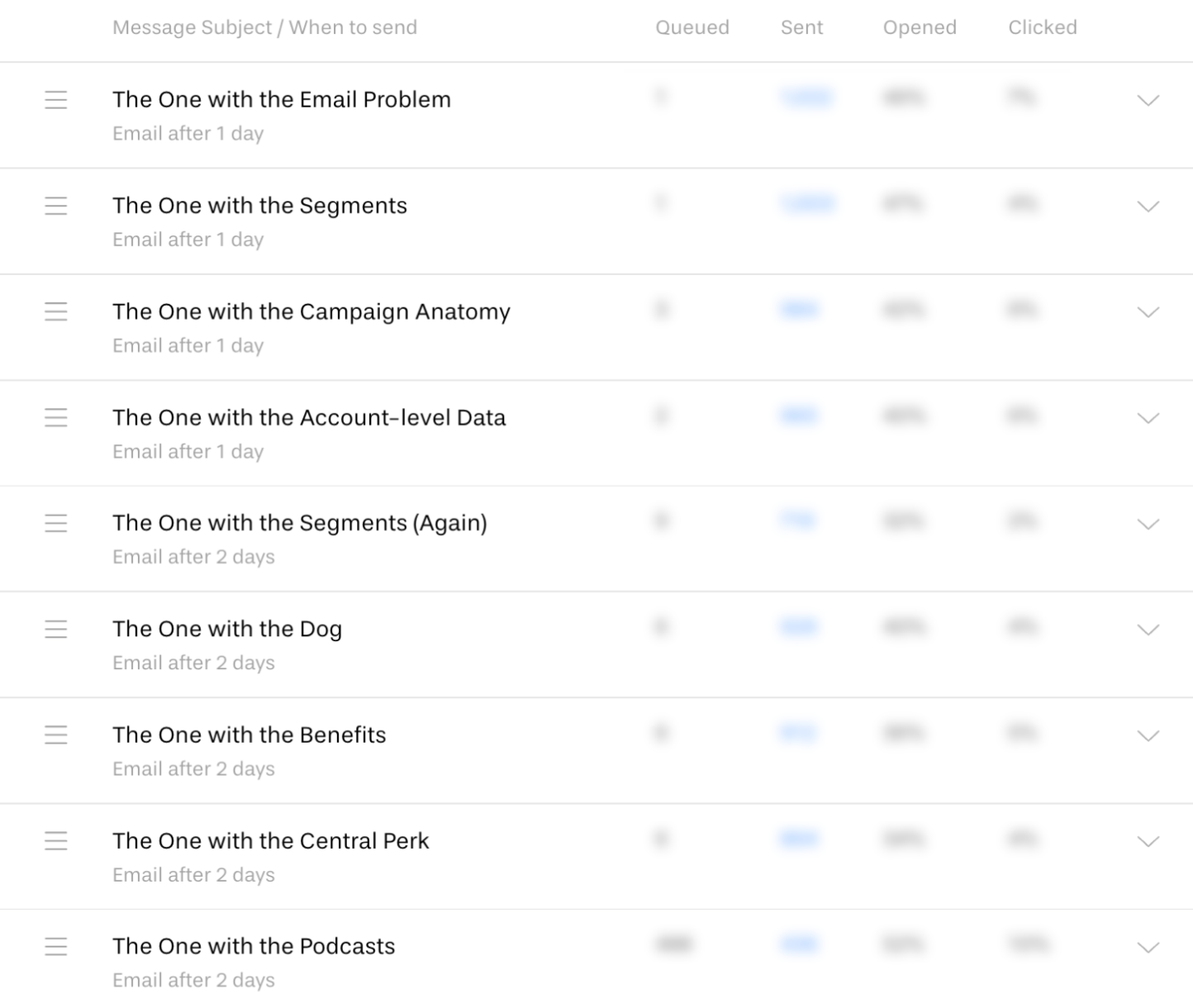
Some more examples of funny subject lines:


Eater Boston: “Where to Drink Beer Right Now” (Sent at 6:45am on a Wednesday.)
OpenTable: “Licking your phone never tasted so good”
Groupon: “Deals That Make Us Proud (Unlike Our Nephew, Steve)”
The Muse: “We Like Being Used”
Fabletics: “Your Butt Will Look Great in These Workout Pants
Warby Parker: “Pairs nicely with spreadsheets”
Baby Bump: “Yes, I’m Pregnant. You Can Stop Staring At My Belly Now.”
Being funny is all about creativity, connecting unrelated elements, and being smart, but also about knowing your audience very well. If you don’t know your audience well enough, then your attempt at humor can be a total miss.
Consider that humor doesn’t have a place in all industries or businesses. For example, you’ll rarely see a financial accounting app using humor.
Curiosity-sparking email subject lines
Humans are curious by nature. We like to understand what’s around us and we don’t want knowledge g_ps. Invoking curiosity is a great way to get your users to open your emails.
There are many ways in which you can spark curiosity in your readers. You can ask questions, say something unexpected, promise more, or leave cliff-
-hangers.
This ‘Hey’ from Barack Obama’s campaign was a great way to invoke curiosity. It didn’t even say what the email was about, but with a simple ‘Hey’ from Obama, you’re sure people were opening that email faster than you can type CC:
His campaign also found out that the simpler and more mundane subject lines did best because they didn’t look salesy, but more like an email you would get from your friends or colleagues.
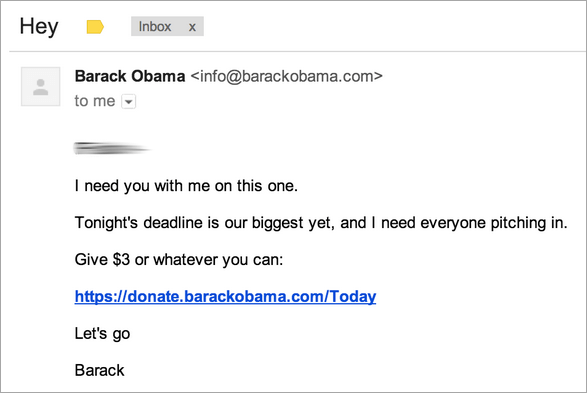
More real-life examples of curiosity-sparking subject lines:


Manicube: “*Don’t Open This Email*”
GrubHub: “Last Day To See What This Mystery Email Is All About”
Digital Marketer: “Is this the hottest career in marketing?”
Thrillist: “What They Eat In Prison”
Eat This Not That: “9 Disgusting Facts about Thanksgiving”
The Hustle: “A faster donkey”
Strong Women, Strong Girls: “Who was Wonder Woman’s Role Model?”
Notice how all these subject lines make you want to learn more, or at least find out what they’re all about? That’s the power or curiosity.
After all, who doesn’t want to know how to get unstuck, or why would anyone tell you to forget your passwords, or know what’s the hottest career in your industry?
Key learnings
People are just as curious as cats — or what the saying makes them out to be. Use this natural curiosity to get your recipients to have to open your email to find out more.
Prices and discounts email subject lines
Seeing how 83% of users said email was their favorite channel to receive promotions — you better seize the opportunity!
People don’t like to pass up on great deals. Whether that’s a discounted price or another type of special offer, these subject lines can really appeal to your audience.
As always, you need to think of your industry and target audience – which is what segmentation will help you with.
You don’t want to be offering discounts to those at the top of your funnel but to those that just need the little nudge — maybe those that have visited your pricing page multiple times or ended their free trial without subscribing.
Some examples of prices and discounts subject lines:

Plus, numbers are a great way to get your users attention. They’re easy to recognize. Additionally, elements like currency characters, or a percentage sign, can tell your reader exactly what they’re getting in just a matter of seconds.
If you use your character count well, you can get your entire message across so only those ready to buy actually open your email. You’re essentially filtering leads with your subject line and creating a higher converting email.
Research found that emails with “free” in the subject line were opened 10% more than those without. Try wording like “free delivery”, “free trial”, “free + product”, or any other offers you can that include the word free.
Keep in mind that you don’t want to sound spammy, so use “free” with enough context and caution.
Pro tip: Robert Cialdini’s first principle of persuasion states that human beings are wired to return favors and pay back debts — it’s called reciprocity. By providing free, exclusive or educational content your users will be more likely to do what you ask them to.
Key learnings
Offering deals and promotions is a great way to create eye-catchy and click-worthy subject lines.
Remember to include numbers, symbols, and words such as:
- Free
- Deals
- Unlimited
- Special offer
Fear-of-missing-out (FOMO) email subject lines
The low-key anxiety and jealousy we get when we feel like we’re missing out on some special occasion can drive people to open almost any email — psychology confirms it.
Scarcity is Cialdini’s sixth principle of persuasion for a reason. Marketing research has proven that when consumers feel something is in short supply — or they have limited time to buy it — they’ll want it more. In turn, increasing clicks, buys, and subscriptions for your SaaS.
To create this sense of urgency and FOMO, use words like:
- Urgent
- Important
- Sold out
- Alert
- Limited
- Seize
- Deadline
- Before you
Or you can even use emojis that can create this sense or urgency like the classic warning sign.
Danty Ishak, owner of Vont, shows a clear example of the success of FOMO email subject lines in an experiment they made:

“You can see the difference in open rates in this email we tested below — one email was intriguing and made people want to hear more about what sold out (FOMO). The other ones are boring and don’t really spark any curiosity for the reader.”
Let’s check some real-life examples of FOMO subject lines:


Awakening this fear of missing out is easy, and pushing product scarcity can help you get the click through rate you want — and need — especially for unique, time-sensitive offers.
Key takeaways
To use FOMO in your email subject lines you need to create a sense of urgency and scarcity through words and even emojis. However, remember to always be honest and to avoid sounding like spam. You don’t want to annoy your recipient with a : “FINAL CHANCE. GET IT NOW. ONLY TODAY!!! ‼️‼️‼️⚠️⚠️⚠️” subject line.
Pain points email subject lines
Another type of subject line that can give you a lot of success are those that address customer pain points.
To deliver these subject lines well, you need to really understand your buyer personas. Without knowing what your audience’s pain points are, you won’t be able to deliver content that relates to their struggles.
Let’s check some real-life examples of pain points subject lines:
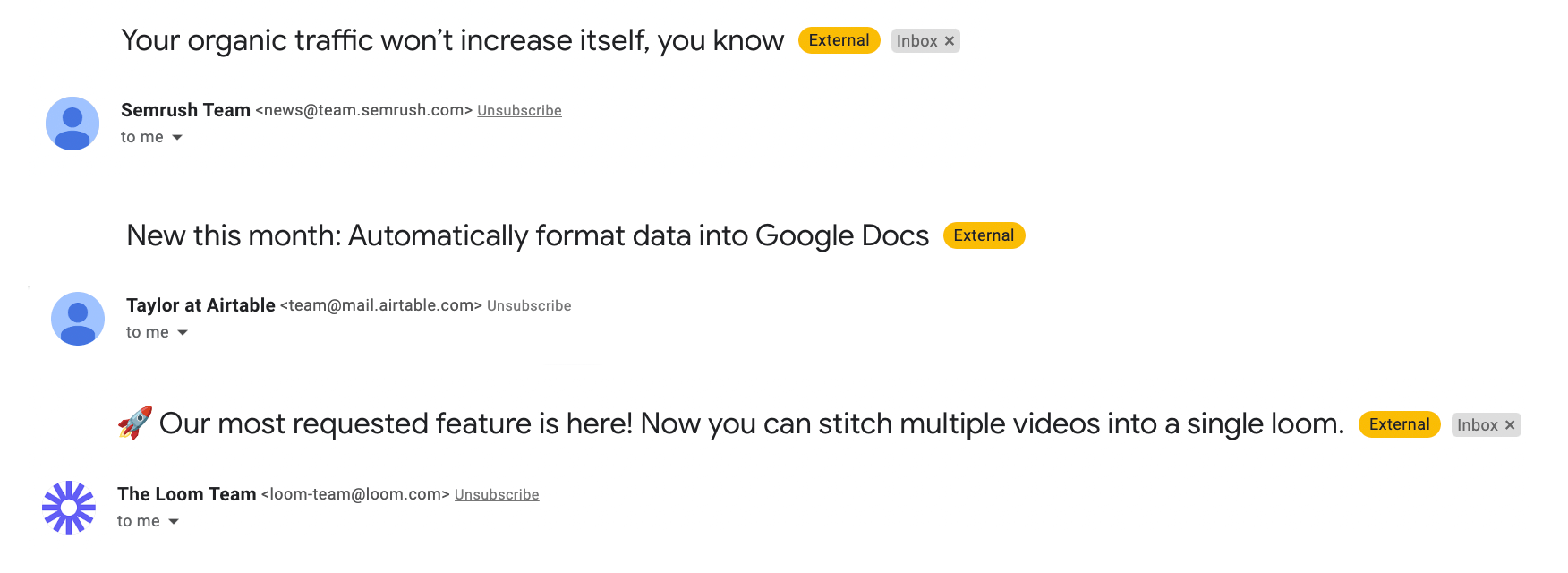

CheapOair: “Fly to Boston for Less with CheapOair!”
ContentWriters: “[White Paper] How to Get Backlinks without Begging: 11 Strategies”
Each of these emails are targeting a pain point that the subscriber needs a solution for. Semrush users want to increase their organic traffic. Airtable users want integrations with their Google Docs, Loom users want to send messages to their teammates on Slack and save time while doing so.
A segment of 123FormBuilder users work with e-commerce and want to use their forms to improve their sales.
Key takeaways
Segmenting by pain points, like Bonsai does during their onboarding questions in the example below, helps you understand what customers’ needs and pain points are. This makes it easier to deliver valuable content, and write subject lines accordingly.
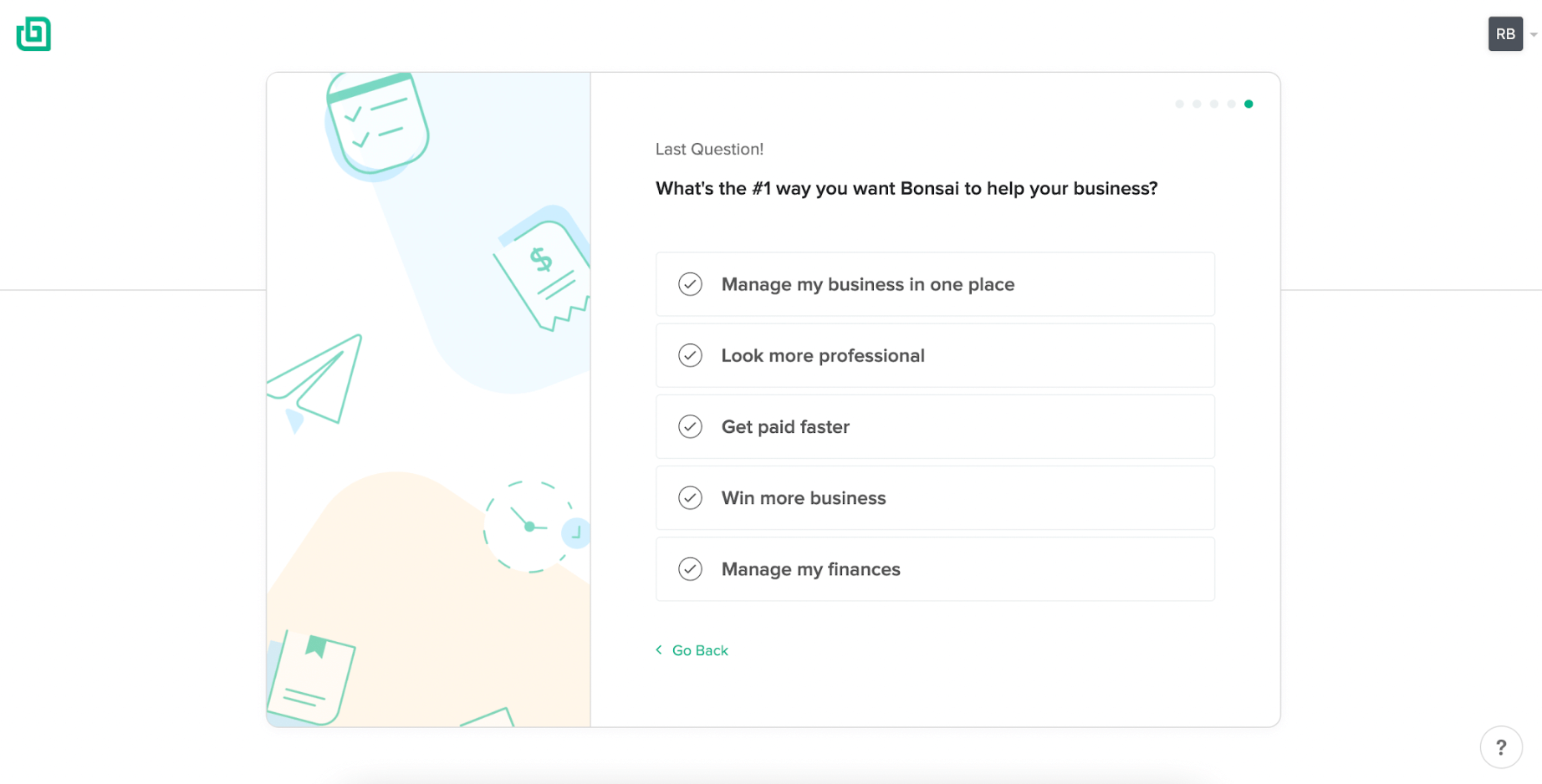
Straightforward email subject lines
For 2022, the average person receives 100 emails per day. It’s time to cut the guesswork, the more straightforward you are, the better.
Let’s check some real-life examples of straightforward subject lines:

Notice how these subject lines are either short questions, or a few words to say what content there is in the email — a newsletter guide, free training, a video, a survey, and more.
Key takeaways
Using these types of subject lines makes your recipient know exactly what’s inside and, if targeted properly, will almost guarantee an opening of the email.
Emoji email subject lines
By using emojis on your subject line you can increase your open rate by 56% — not a number to ignore.
Emojis help you seem more friendly, and express emotion or messaging without using extra characters.
Just as with all the other types of subject lines, it depends on whether or not you know your subscribers. For some types of emails, emojis aren’t appropriate.
Think about financial SaaS, for example. People rarely like to see their money being considered so lightly.
It’s best if you can test the type, placement, and amount of emojis. Aiming for relevancy is always a must, so focus on understanding how, when, and why your audience would appreciate emojis.
Let’s check some real-life examples of emojis in subject lines:

Key takeaways
Emojis make the email stand out and help give recipients more of an idea about the tone and content of the message.
26 SaaS email subject line formulas for your next campaign
Need a paint-by-numbers subject line for your next email campaign? Here are some templates.
Funny email subject lines
The One with the + [pain point, topic of interest, main subject of the email]
I like [product] as my wine — sweet and victorious. What about you?
Shaken, not stirred. 🍹 A [adjective][resource] you asked for.
What [industry relevant thing] has in common with [mundane thing]?
What do you and [industry known person] have in common?
[referral name] said to say hello to their buddy 🙋
Curiosity-sparking email subject lines
How to [industry relevant action] like a pro
Why [industry relevant element] is key for [industry relevant outcome]?
What they [unexpected action] in [industry relevant place/role]
[Unexpected listicle specific to the industry]
Prices and discounts email subject lines
⚠️ Last chance to try [product] for $[X]
Start [product-related action] for only $[X]/month
Just for you: get [XX]% off your first year with [company]
Hot Summer Deals Just for You 🔥
[Product] unlimited. Yours for the next [X] days
Fear-of-missing-out email subject lines
Last day! [X time period] for only $[X]‼️
It’s your last chance! [special offer] ⚠️
Your FINAL chance for [XX]% discount
You have [X] days to get your [special offer]
Pain points email subject lines
Your [client pain point] won’t improve itself, you know
New this month: [client pain point educational material]
Solve [client pain point] today
Straightforward email subject lines
Ready to make a [product-related action]?
Quick question: how are we doing?
What do you think about [product]?
Here’s your [relevant product documentation]
Don’t wait for the muse. Apply this step-by-step method to write high-performing email campaigns in hours, not weeks.
Let’s recap the best practices
As we’ve seen, email subject lines come in many flavors. Depending on your audience, your message, your industry, and other factors they can vary greatly, from mysterious and curiosity-inspiring to straight-to-the-point copy.
However, there are some best practices that apply to all email subject lines.. Those are:
Segmenting and personalizing your user lists
The best way to ensure that you’re messaging the right audience, is by segmenting your users properly. When you segment them, you’ll know more about who they are, what they like, and where they’re at in your funnel. This way, you’ll be able to deliver more effective and relevant email campaigns.
Subject lines that are personalized — for example, by adding the name of the recipient, company, messaging recipients on their birthday or depending on their job role — are 22% more likely to be open than those without it.
Natalia Brzezinska, Marketing & Outreach Manager at PhotoAid, shares her views on personalization:
“Personalization is the most important thing to make subject lines successful. You can use all the mentioned strategies, and if the line’s message won’t be relevant to the reader’s niche - you’ll fail.”
With Userlist, you can segment your SaaS customers dynamically based on what they do in your product. Then trigger automated campaigns when users join or leave a segment.
Relevancy is also important and it comes from studying and knowing who your audience is and what they’ll need.
Roberto Popolizio, PR Manager at Supporthost.com, explains how he once got an email offering a sponsored link, to which he says:
“If this person had spent 10 minutes to find what I do for a living, and looked at a couple of posts on our blog, they could have realized that as an SEO I am very unlikely to pay money for a “sponsored” link, and that I get emails like that all the time. The very first word in their subject line destroyed any chance to get me interested. Epic fail.”

Another way to increase your relevancy is by sending behavior-triggered email campaigns — FW: Userlist can help you. This way, users will be receiving an email as a response to something they did on your website or product.
Consider the ‘from’ field and preheader
Not only is the subject line important, you also need to pay attention to what else the user can see without opening the email: the preheader and the ‘from’ field.

The preheader is essentially the blurb of what the email will be about. It’s also known as the Johnson Box and is a short summary to get the reader even more excited about the contents of the email.
Knowing that readers don’t only look at the subject line but also at the things around it is key for giving your emails a real chance at getting opened. Ensure the preheader is included and provides a great summary of the content of the email.
For preheaders, the ideal length is 40-130 characters, this ensures recipients can see them on desktop and mobile devices.
Seeing how 25% of email recipients have opted out of brand emails because of a lack of human touch — make sure your ‘from’ field looks ‘human’. To do this use an actual email — support@company.com or liame@company.com – and not from a spam-looking noreply@company.com email.
Get your sending time right
Your users want to feel seen by your brand. If you prove that you’re taking care of them, down to the details of the time that you’re messaging them, they’ll feel more inclined to open your emails. No one wants to get an email at midnight or 6pm on a Friday.
Take into account that timing goes beyond geography and varies depending on your industry and customer base. This will help you send your emails when they have the biggest chance of getting opened and read.
According to research, the best email sending times are:
- Morning: between 9-10 am, with an average open rate of 21.35%.
- Noon: between 1-2 pm, with an average open rate of 22.09%.
- Afternoon: between 5-6 pm, with an average open of 20.74%.
Consider subject line length
Subject lines that are short have the advantage of not being cut off by different mobile devices or email providers. MailChimp recommends using no more than 9 words or 60 characters.
However, keep these numbers in mind:
- Outlook shows 78 characters on a browser on a 15″ laptop
- Gmail on an iPhone displays 36-38 characters
- Yahoo mail displays 38-42 characters on an iPhone
Knowing which platforms and devices your audience is using to check your emails will be of great help. However, staying below 41 characters for iPhones, and 70 for Gmail is ideal.
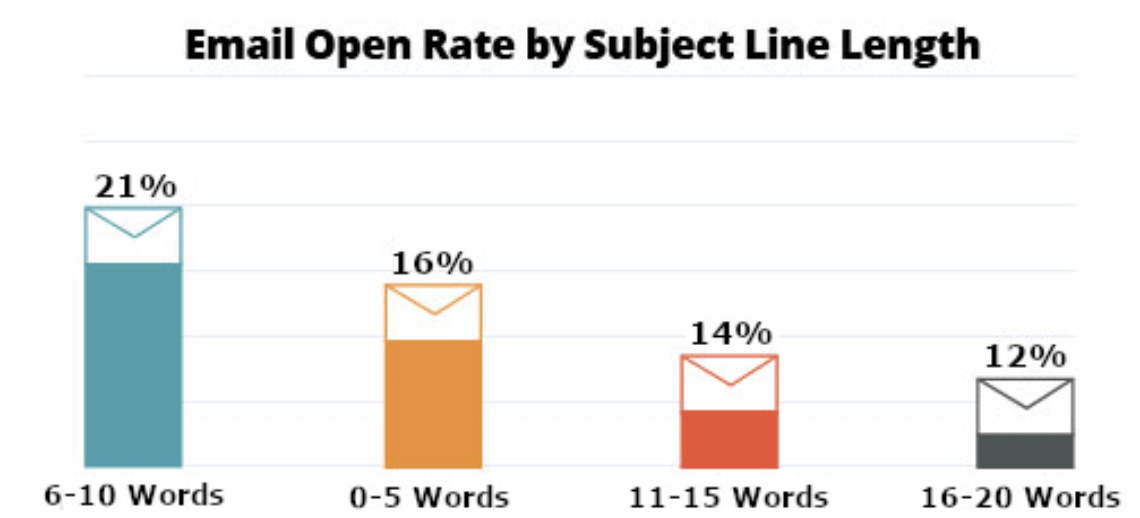
Make it mobile-friendly
Leslie Venetz, founder of Sales Team Builder, explains why mobile-friendliness is so important:
“85% of your prospective buyers are looking at your email for the first time on their mobile, which means there is space to read the subject lines & a few words from the opening sentence. The best subject lines make the reader want to take a second look so they don’t automatically delete your email from their mobile.”
Always focus on value
At the end of the day, your subject line will get people clicking on your email. But if you’re constantly providing no value for them, it won’t matter how good your subject line is. Focus on always giving your readers what they need and want within your email copy. Your subject line is an invitation to this.
SaaS email subject line blunders to avoid
By now you know what to do, but it’s also important what not to do when it comes to email subject lines.
- Mimicking personal intros (Jane <> Userlist)
- Generating false urgency (ALERT!, etc)
- Misleading information to grab attention (click-bait)
- Spammy words, too many emojis, or all caps
- Jargon or confusing wording
- Repeat subject lines
- RE: or FW: on your subject lines
- Lengthy subject lines
- Un-personalized subject lines
- No subject line at all
Here are a few expert opinions on what makes a spam-folder-worthy subject line:
Georgi Todorov, CEO and founder at Thrive My Way, says:
“A bad subject line has too much urgency and tries to scare the reader into opening the email. These look like spam, and you can be guaranteed that a subject line like “Georgi, you won’t believe what I found out last night” will remain unopened.”
Mariusz Michalowski, Community Manager atspacelift.io, add to this:
“Click baiting, shock value, negative words, emotional digs, and lots of emojis are all becoming too saturated due to overuse by the companies. The good email subject lines are basic and straightforward, like the lines our friends used in emails.”
Subject lines to avoid:
- “You won’t believe this!”
- “This will only take a second”
- “Hey, check out my new blog post!”
- “Can I ask for a favor?”
- “Crazy offer inside!”
- “Did you miss us?”
These subject lines provide such little information, that the reader is likely to assume they’re spam. Being clear, concise, and direct in your subject lines will help you get the right clicks, but provide enough context to jog a foggy memory.
Some example subject lines that deserve a seat in the spam folder
Being so general it isn’t appealing to your audience:

Not including a subject line:

Look like a spam, and you’ll be sent to spam

How to measure your email subject lines and which tools to use
When you seize the tools that are available, you can ensure that technology is in your favor and get some winning subject lines to your recipients.
There are many tools to choose from, so, we’ve made things easier for you and compiled a list of the five tools you definitely need in your arsenal.
Five tools to improve your subject line game:
- Test subject lines on mobile devices with Text Subject by Zurb
- Avoid being flagged as spam with Spam Check by Postmark
- Test the length and find out the subject line type with Email Subject Line Grader
- Check for deliverability and marketing results with SubjectLine
- Use AI-technology to test your subject lines with Mizy or Ortto
Another thing to consider when you’re A/B testing your emails is you want to make sure you’re measuring and analyzing the following metrics:
- Open rate: amount of people that opened your email. This helps you see how effective your subject line and preview were
- Click through rate: amount of subscribers that clicked on the links and call-to-action buttons inside your email. This helps you assess your email content and it’s performance
- Reply rate: amount of recipients that sent a valid response to your email. This helps measure the engagement with your email campaign
Write subject lines that get the open rate you deserve
An email subject line is the first — and sometimes the only— opportunity that you have to get your recipients to open your emails. Using the psychology tactics and email best practices described here you can ensure your emails get seen, replied to, and clicked on by the right people. You’ll even win a forward or two!
Give your SaaS email marketing the chance it deserves. In just a few characters, create the right impulse to open and engage with your emails giving your content the screen-time it needs.
Don’t miss out on new articles. Subscribe to our newsletter and get your monthly dose of SaaS email marketing insights.






